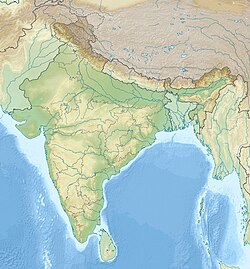Ooty Radio Telescope

Radio Telescope at Ooty
|
|
| Location(s) | Muthorai |
|---|---|
| Coordinates | 11°23′00″N 76°39′58″E / 11.383404°N 76.66616°ECoordinates: 11°23′00″N 76°39′58″E / 11.383404°N 76.66616°E |
| Organization |
Tata Institute of Fundamental Research |
| Altitude | 2,240 m (7,350 ft) |
| Wavelength | 0.92 m (330 MHz) |
| Built | 1965–1969 |
| First light | 1970 |
| Telescope style |
radio telescope, Cylindrical Paraboloid |
| Length | 530 m (1,738 ft 10 in) |
| Width | 30 m (98 ft 5 in) |
| Collecting area | 16,000 m2 (170,000 sq ft) |
| Mounting | Equatorial mount |
| Website | rac |
|
|
|
|
[]
|
|
The Ooty Radio Telescope is located in Muthorai near Ootacamund (Ooty), south India. It is part of the National Centre for Radio Astrophysics (NCRA) of the well known Tata Institute of Fundamental Research (TIFR) which is funded by the Government of India through the Department of atomic energy. The Ooty Radio Telescope (ORT) is a 530-metre (1,740 ft) long and 30-metre (98 ft) wide Cylindrical Paraboloid telescope. It operates at a frequency of 326.5 MHz with a maximum bandwidth of 15 MHz at the front-end.
The Ooty Radio telescope has been designed and fabricated with domestic Indian technological resources. The ORT was completed in 1970 and continues to be one of the most sensitive radio telescopes in the world.
Observations made using this telescope have led to important discoveries and to explain various phenomena occurring in our solar system and in other celestial bodies.
The reflecting surface of the telescope is made of 1100 thin stainless-steel wires running parallel to each other for the entire length of the cylinder and supported on 24 steerable parabolic frames.
An array of 1056 half-wave dipoles in front of a 90 degrees corner reflector forms the primary feed of the telescope. It has an angular resolution of 2.3deg x 5.5sec(dec)'.
The structure of the radio telescope was designed in July 1963. Muthorai village near Ooty was selected as the suitable location and the construction work began in 1965. The telescope was completed in 1969. Normal post commissioning and calibration use began in 1971.
The large size of the telescope makes it highly sensitive. As an example, it is in principle capable of detecting signals from a mere 1 watt radio station located 10 million km away in space. The telescope sits on a natural slope of 11°, which matches the latitude of the location. This gives the telescope an equatorial mount which allows tracking of celestial sources for up to ten hours in the east-west direction. In the north-south direction, the telescope operates as a phased-array and is steerable by varying the phase gradients
...
Wikipedia

